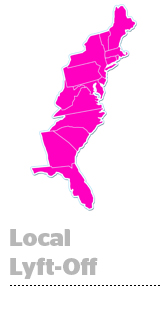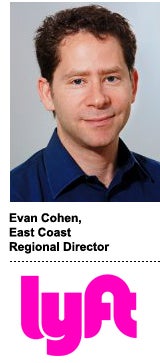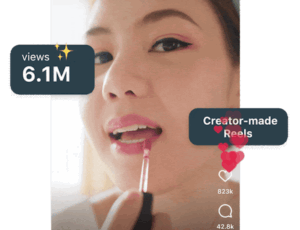 Lyft’s marketing strategy is a bit like a wheel, with spokes radiating from a central hub.
Lyft’s marketing strategy is a bit like a wheel, with spokes radiating from a central hub.
Lyft’s San Francisco headquarters is still its nerve center, but about a year and a half ago Lyft started ramping up its regional marketing efforts with the hire of former Foursquare exec Evan Cohen as head of East Coast operations.
“At the beginning, the philosophy was to be cookie-cutter so we could move fast and, indeed, that’s how we were able to open in 200 cities quite quickly,” said Cohen, who joined Lyft in December after almost five years at Foursquare, where he was employee No. 6.
At Lyft, Cohen has six major markets under his purview: New York, Boston, Washington, DC, Philadelphia, Baltimore and New Jersey. Each has a general manager and smaller teams focused on building and supporting the driver communities, reaching out to passengers and spearheading local marketing efforts.
It’s a big job, considering Uber’s three-year head start on the East Coast.
“We quickly realized that we could optimize and improve if we had local teams in key markets,” Cohen said. “And we’ve been learning how to balance those two dynamics: the localized teams and the centralized resources.”
AdExchanger caught up with Cohen to talk local marketing, measurement and location.
 AdExchanger: What is Lyft’s regional rollout strategy in a nutshell?
AdExchanger: What is Lyft’s regional rollout strategy in a nutshell?
EVAN COHEN: We’ve learned, and this is perhaps not surprising, that when you put local teams on the ground, you have a far better sense of the pulse of that market and a much better opportunity to build community. On the passenger side it’s been about working with local festivals, businesses and partners to tailor messages locally.
We still have a big central marketing team in San Francisco that manages efforts that are national in scope and our paid acquisition efforts. They spend millions of dollars a month on Facebook, Twitter and Google ads. It doesn’t make sense for that kind of marketing function to be out in the field with small teams. It takes a lot of expertise, and we have several full-time experts focused on that in San Francisco.
What are some examples of Lyft’s local marketing efforts?
Each city has a marketing lead that I help hire, manage, train and sometimes support. In New York City, for example, the marketing leads set up and manage high-profile investments in festival sponsorships, like what we did last summer in Central Park as part of the SummerStage concert series and Celebrate Brooklyn, which manages concerts in Prospect Park. We had signage on stage and a big booth that was pink and well-branded. We have ambassadors, often college students, who interact with passengers. And in some cases, we integrate with the ticket-buying system so people can book a car at the same time they book a ticket.
We were a big sponsor of the [Brooklyn] Nets last year and at halftime at Barclay Center, all of the signs inside would turn pink, and after the game we had a special pickup zone outside the stadium. Another example is a partnership we struck with a local Mexican restaurant in Boston. If you ordered a Lyft you got a coupon for $8 or $10 at the restaurant. People were taking rides with us to get free burritos.
Those kinds of local marketing programs take a lot of time to set up and negotiate.
How do you think about attribution and measurement?
We think about it all the time because we’re operating at such scale – literally millions of dollars are going through our system – so it behooves us to spend as wisely and as targeted as possible.
We have unique coupon codes for all of our partners and for each event, which lets us know how successful we are, but it’s definitely harder to measure general brand impact.
Billboards, advertising on bus stops, TV commercials – that’s all explicitly brand-building oriented. We know that there’s a lot of value to having signs on the stage of a Central Park venue, for example, but it’s hard to measure. We do very systematic brand awareness surveys every quarter around the country to try and determine efficacy, measuring unaided awareness of brand and intent to use.
What about user acquisition and tracking downloads?
We measure that funnel very tightly and we try to optimize on a weekly basis with our big publisher partners, like Facebook and Twitter, where we run install ads to get users on mobile.
We look at how many people click, how many of the people who click go on to download, how many of those people create users accounts and of that group, how many people actually use the app. Those are the four main levels of our funnel and we’re constantly tweaking the messaging to improve conversions.
You spent a long time at Foursquare. What’s your take on how location-based advertising will impact the ride-sharing space?
Right now, it’s an untapped opportunity for all companies in this space, but it’s definitely something we hope to lean into. The real opportunity – and this is throwing the ball down the field five years – is in the world of autonomous.
Lyft knows where people are driving, so I can imagine a world where a car intelligently offers recommendations on where to stop for lunch, perhaps based on what’s popular in the area or perhaps based on paid advertising. My mind is oriented in this direction coming from a Foursquare point of view, but it’s not something we’ve seen in the ride-sharing space – yet.














